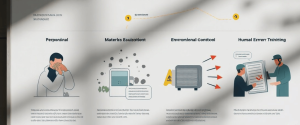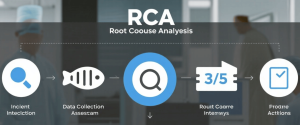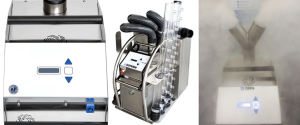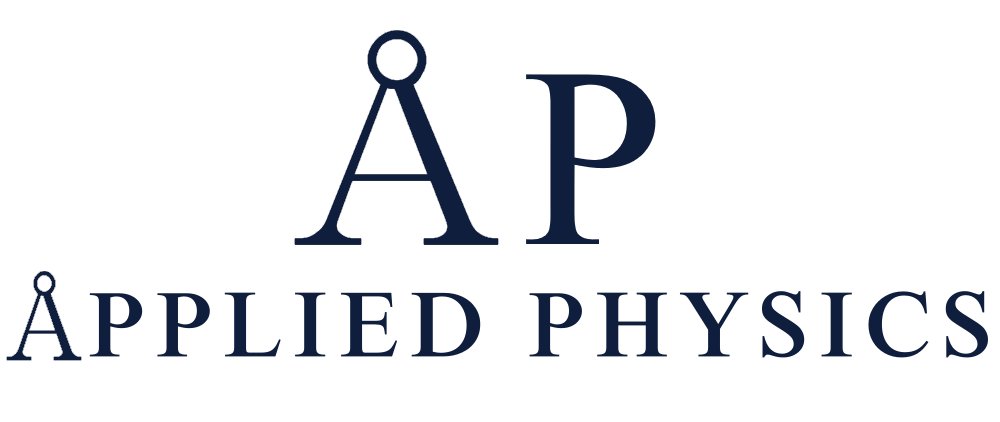Cleanrooms are the backbone of critical manufacturing industries such as semiconductors, pharmaceuticals, biotechnology, and electronics.
These highly controlled environments are designed to minimize contamination and ensure product quality. However, even with stringent protocols, cleanroom failures can and do occur, leading to costly yield losses, regulatory setbacks, and compromised product integrity.
This article explores the root causes of cleanroom failures, the impact on manufacturing yields, and how advanced fogger technology is revolutionizing root cause analysis and contamination control.
Common Failure Modes in Cleanrooms
Despite rigorous design and operational protocols, cleanrooms are susceptible to several failure modes that can compromise their integrity and performance:
1) Contamination Control Failures
- Personnel: Human activity is a major source of particulate and microbial contamination. Inadequate gowning, hygiene, or training can lead to increased contamination.
- Materials and Equipment: Use of inappropriate or shedding materials or poorly maintained equipment can introduce particles or off-gassing chemicals.
- Cleaning Products: Non-approved cleaning agents may introduce contaminants rather than remove them.
2) Environmental Control Failures
- Air Filtration and Circulation: Incorrect filter selection, poor airflow patterns, or insufficient air changes can allow contaminants to accumulate.
- Pressure Differentials: Failure to maintain proper pressure gradients can result in unfiltered air entering cleaner zones.
- Temperature and Humidity Fluctuations: Variations can disrupt sensitive processes and affect product quality.

3) Equipment and System Failures
- HVAC System Malfunctions: Failures can quickly lead to loss of environmental control, since HVAC systems account for 50–75% of cleanroom energy use.
- Monitoring System Failures: Inadequate or malfunctioning monitoring systems delay the timely detection of deviations, increasing contamination risk.
4) Human Error and Training Deficiencies
- Inadequate Training: Lack of continuous training leads to procedural errors and non-compliance.
- Documentation Errors: Poor record-keeping can result in compliance breaches and compromised research integrity.
Root Cause Analysis (RCA) in Cleanroom
Why RCA Is Essential
Root Cause Analysis (RCA) is a systematic process for identifying the underlying causes of failures or contamination events in cleanrooms.

Effective RCA helps prevent recurrence, ensures compliance with industry standards, and protects product integrity.
RCA Methodologies for Cleanrooms
- 3/5 Whys Technique: Iterative questioning to drill down to the fundamental cause of a problem.
- Fishbone (Ishikawa) Diagram: Visual mapping of possible sources of contamination, grouped into categories such as Personnel, Equipment, Materials, Methods, Environment, and Management.
- Statistical and Trend Analysis: Use of data to uncover patterns or anomalies in cleanroom performance.
- Extended Cause-Effect Chain Analysis (CECA): Mapping out longer chains of events and interactions, especially useful in complex manufacturing environments.
RCA Workflow
- Incident Identification: Detect and document the failure or contamination event.
- Data Collection: Gather environmental monitoring, process logs, and personnel records.
- Initial Assessment: Brainstorm possible causes using tools like the Fishbone diagram.
- Root Cause Identification: Apply the “3 Whys” or “5 Whys” technique, and validate with statistical analysis.
- Corrective Actions: Develop and implement measures to address the root cause.
- Verification: Monitor the effectiveness of corrective actions.
Impact of Cleanroom Failures on Manufacturing Yields
Impact of Cleanroom Failures on Yields and Profitability
- Yield Loss: Even tiny particles or contaminants can cause defects, malfunctions, or failures in electronic devices and pharmaceuticals. In semiconductor manufacturing, undetected particle contamination can lead to poor product quality, reduced yields, and significant revenue losses.
- Increased Costs: Lower product yields mean more waste and less revenue. For example, if defective parts contaminated in a cleanroom are installed in manufacturing processes, the resulting yield loss can be substantial.
- Regulatory and Operational Risks: Non-compliance with cleanroom standards can lead to regulatory delays, fines, or shutdowns.
- Material Cost Sensitivity: With manufacturing material costs rising by 2.7% in 2025, preserving yield is more critical than ever.

We: Leading Cleanroom Fogger Solutions
- CRF6 Cleanroom Fogger: 213 ml/min fog density, 2.0 m³/min output, up to 45 minutes per fill—ideal for medium to large cleanrooms.
- AP35 Ultrapure Fogger: 533 ml/min fog density, 5 m³ per fill, produces contaminant-free fog for high-sensitivity environments.
- CRF4 Portable Fogger: Designed for compliance with ISO 14644-3, USP797, and other standards; portable for routine checks.
- CRF2 Fogger: Low-cost ultrasonic fogger for small environments like fume hoods.

All models are engineered to minimize particle generation, support compliance with international standards, and provide dense, visible fog for effective airflow mapping and leak detection.
Best Practices for Using Foggers in Cleanroom RCA
- Select the Right Fogger: Match fogger type and fog material to the cleanroom class and investigation needs.
- Optimize Injection Technique: Inject fog perpendicular to airflow for accurate visualization.
- Document Findings: Use video and multiple camera angles to record airflow studies for compliance and training.
- Integrate with RCA: Use fogger results to inform Fishbone diagrams, 5 Whys analysis, and corrective action planning.
Conclusion
Cleanroom failures are a leading cause of yield loss, product recalls, and regulatory action in critical manufacturing industries.
Root cause analysis, supported by advanced fogger technology, provides a powerful toolkit for identifying, resolving, and preventing these failures.
By visualizing airflow, detecting leaks, and tracing contamination sources, foggers enable manufacturers to maintain cleanroom integrity, maximize yields, and ensure compliance with the most stringent industry standards.
As material costs rise and regulatory scrutiny intensifies, investing in robust RCA methodologies and state-of-the-art fogger solutions is more important than ever for operational excellence and business success.
Frequently Asked Questions (FAQs)
1. How do foggers help prevent cleanroom failures?
Foggers make invisible airflow patterns visible, allowing for the detection of leaks, dead zones, and improper air circulation—key contributors to contamination and cleanroom failures.
2. Are foggers safe for all cleanroom environments?
Yes, when properly selected. Ultrapure and glycol-based foggers are designed to avoid introducing contaminants and are suitable for even the most sensitive environments.
3. Can foggers be used for regulatory compliance?
Absolutely. Fogger-based airflow visualization is required by standards such as ISO 14644-3 and is often requested during regulatory audits.


